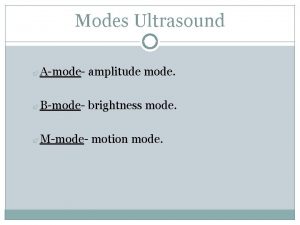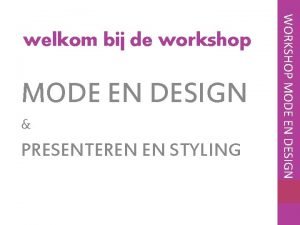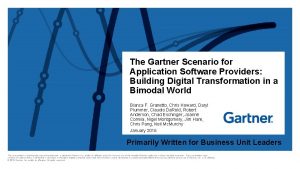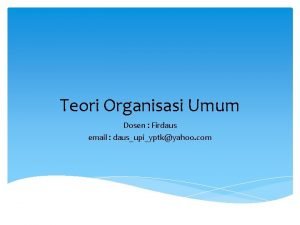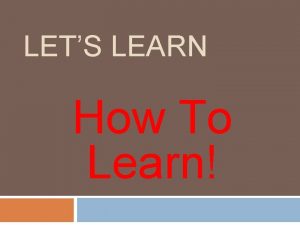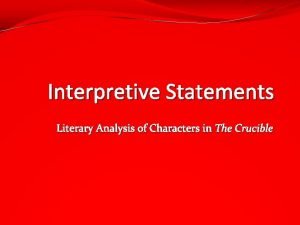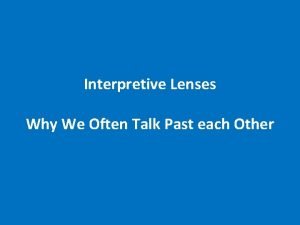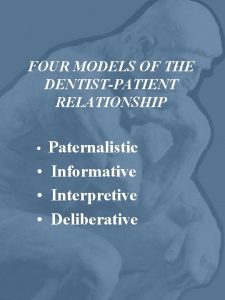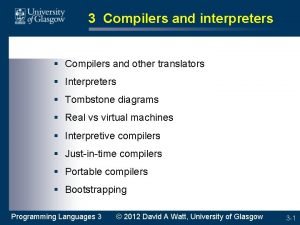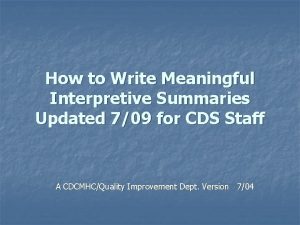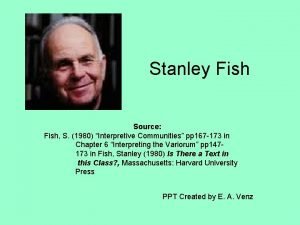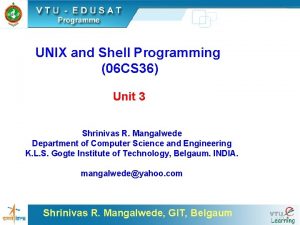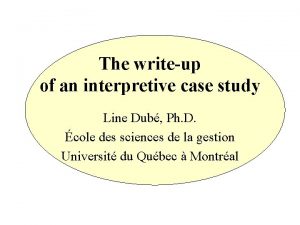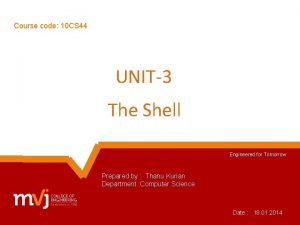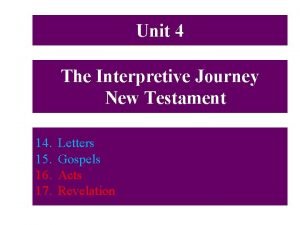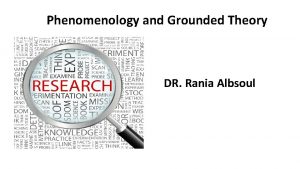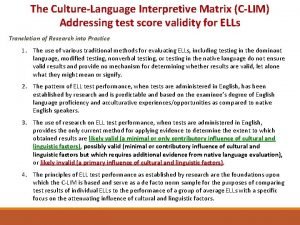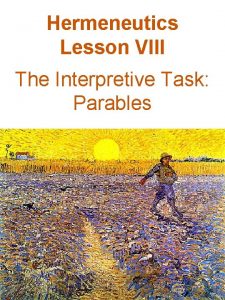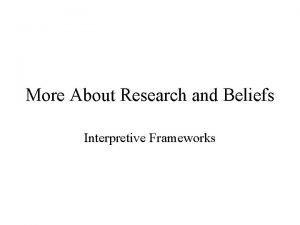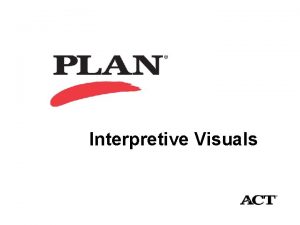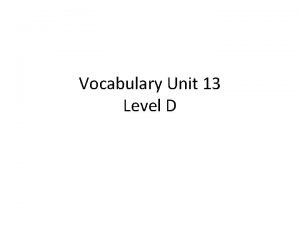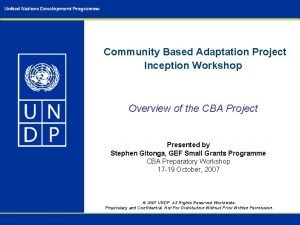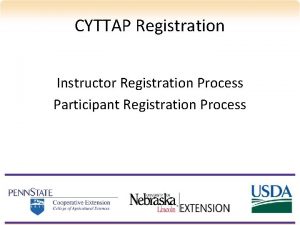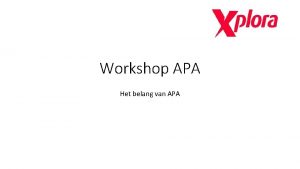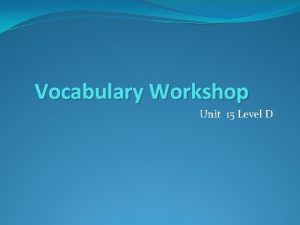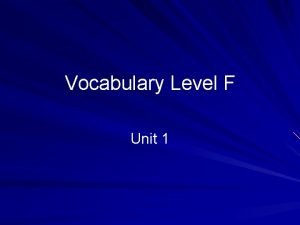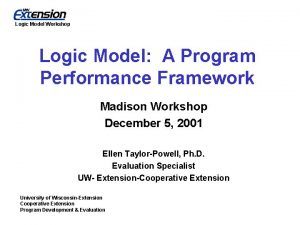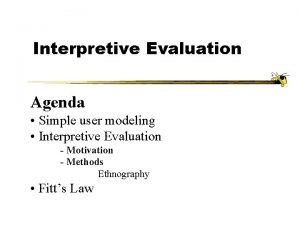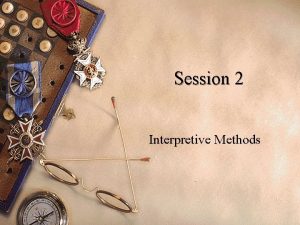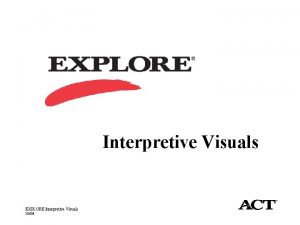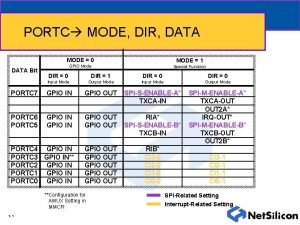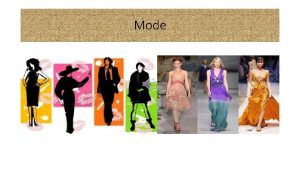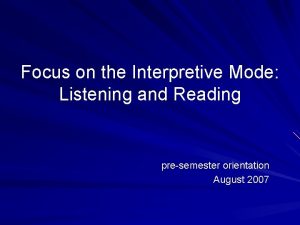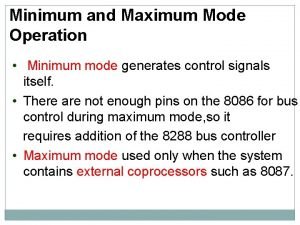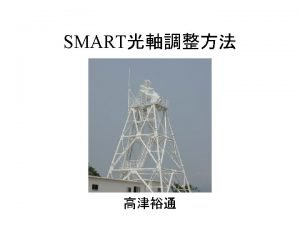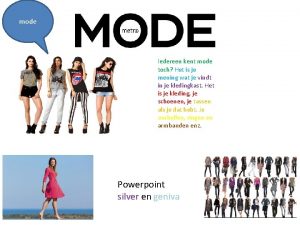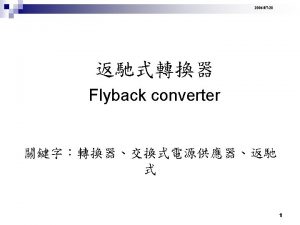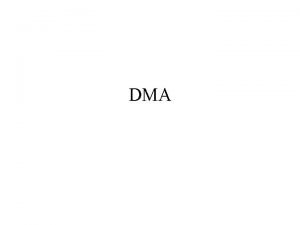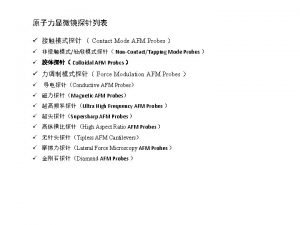Interpretive Mode FlagshipProject Go Teacher Workshop U of











































- Slides: 43

Interpretive Mode Flagship/Project Go Teacher Workshop, U. of Utah July 26, 2016 Jennifer Bown, Brigham Young University

Who am I?

Objectives • Identify a passage that can form the basis of an Integrated Performance Assessment • Design a comprehension guide for the passage

Overview • • Definitions Processes Involved in Listening and Reading Models of Comprehension Differences Between Listening and Reading L 1 vs L 2 comprehension processes Factors Affecting Comprehension Principles of Teaching Integrated Performance Assessment

Definitions: Interpretive Mode • “The appropriate interpretation of meanings, including cultural, that occur in written and spoken form (read, heard, or viewed) when there is no recourse to the active negotiation of meaning with the writer or speaker. ” (Adair-Hauck, Glisan, & Troyan, 2013, p. 9). Adair, Hauck, B. , Glisan, E. W. , & Troyan, F. J. (2013). Implementing Integrated Performance Assessment. Alexandria, VA: ACTFL.

Definitions: Reading • “Reading is the ability to draw meaning from the printed page and interpret this information appropriately. ” (Grabe & Stoller, 2011, p. 3). • Proficient reading: “The active, automatic, far-transfer process of using one’s internalized language and culture expectancy system to efficiently comprehend an authentic text for the purpose for which it was written. ” (Clifford & Cox, 2013, p. 50). • “Reading is a selective process. It involves partial use of available minimal language cues selected fro perceptual input on the basis of the reader’s expectation. As this partial information is processed, tentative decisions are made to be confirmed, rejected or refined as reading progresses. ” (Goodman, 1967, p. 126) Clifford, R. , & Cox, T. (2013). Empirical validation of reading proficiency guidelines. Foreign Language Annals 46: 45 -61. Goodman, K. S. (1967) Reading: A psychological guessing game. Literacy Research and Instruction 6(4): 126 -135. Grabe, W. , & Stoller, F. L. (2011). Teaching and Researching Reading (2 nd ed. ) Pearson: Harlow, England.

Definitions: Listening • “A process of receiving what the speaker actually says (receptive orientation); constructing and representing meaning (constructive orientation); negotiating meaning with the speaker and responding (collaborative orientation); and creating meaning through involvement, imagination and empathy (transformative orientation). Listening is a complex, active process of interpretation in which listeners match what they hear with what they already know. ” (Rost, 2002; cited in Vandergrift, n. d. ) Vandergrift, L. (n. d. ) Listening: Theory and practice in modern foreign language competence. https: //www. llas. ac. uk/resources/gpg/67 (accessed July 17, 2016).

Comprehension Processes • Word recognition • Syntactic parsing • extracting of basic grammatical information to support clauselevel meaning • recognize phrasal groupings, word ordering information, subordinate and superordinate relationships • Semantic Proposition Formation • combining word meanings and structural information into basic clause-level meanings

Comprehension Processes Roughly, in each and every two seconds of reading, fluent readers [and listeners]: 1. focus on and access eight to ten word meanings 2. parse a clause for information and form a meaning unit 3. figure out how to connect a new meaning unit into the growing text model 4. check interpretation of the information according to their purposes, feelings, attitudes and background expectations, as needed 5. monitor their comprehension, make appropriate inferences as needed, shift strategies and repair misunderstanding, as needed 6. resolve ambiguities, address difficulties and critique text information, as needed (Grabe & Stoller, 2011, p. 23) Grabe, W. , & Stoller, F. L. (2011). Teaching and Researching Reading (2 nd ed. ) Pearson: Harlow, England.

Activity • First, read the paragraphs on the following slides to yourself. • Next, with a partner discuss the paragraphs. Make a list of the five most important words/terms from the paragraphs. • Share your ideas with the group.


Atleta sulcoreano passa mal e técnico culpa água da baía de Guanabara • O velejador sulcoreano Wonwoo Cho, da classe RSX, passou mal na última terçafeira após participar do eventoteste da Olimpíada na baía de Guanabara. O treinador da equipe, Danny Ok, atribuiu os sintomas à má qualidade da água. De acordo com texto publicado pelo técnico no Facebook, Cho teve febre, vomitou e ficou desidratado na noite de segunda. Ele foi levado ao hospital Samaritano, não disputou as regatas de terça, mas voltou para a água na quarta. • "Mais de dez anos de esforço de vida pode ser destruído em um dia. Essa não é uma situação de emergência, mas é muito desapontador. Eu espero que o COI [Comitê Olímpico Internacional] e a Isaf [federação internacional de vela] considere como a questão da segurança [da água] vai melhorar para o próximo ano", escreveu Ok.

Strategies • Was one of the paragraphs easier to read? • If so, which one? Why? • What strategies did you use to help you comprehend what you were reading?

Strategies • For the Portuguese paragraph, you might have used some of the following strategies: • Looked for words you knew • Looked for words that resembled English words • Asked a Portuguese speaker for help

Models of Comprehension • Bottom-up processing • Top-down processing • Interactive Approach

Bottom-up Processing • Reader builds meaning from the smallest units of meaning to achieve comprehension. • Example • letters letter clusters words phrases sentences longer text meaning = comprehension

Problems with bottom-up • This model has a tendency to depict the information flow in a series of discrete stages, with each stage transforming the input and then passing the recorded information on to the next higher stage. • It is difficult to account for sentence context effects and the role of prior knowledge of text topic as facilitating variables in word recognition and comprehension (because of lack of feedback). • The decoding model is inadequate because it underestimates the contribution of the reader who makes predictions and processes information. It fails to recognize that students utilize their expectations about the text, based on their knowledge of language and how it works.

Top-down Processing • Reader generates meaning by employing background knowledge, expectations, assumptions, and questions, and reads to confirm these expectations. • Example • Pre-reading activities (i. e. activating schema, previewing, and predicting) + background knowledge (cultural, linguistic, syntactic, and historical) = comprehension Aebersold, J. & Field, M. L. , (1997). From reader to reading teacher: Issues and strategies for second language classrooms. New York: Cambridge University Press.

Schema Theory-What is a Schema? “A mental model or representation built up through experience about a person, an object, a situation, or an event. ” (Head, 1920) “Organised structures of knowledge and expectations of some aspect of the world. ” (Bartlett, 1932) Bartlett, F. C. (1932). Remembering. London: Cambridge University Press. Head, H. ( 1920). Studies in Neurology (vol. 2). London: Hodder & Stoughton.

Schema of an “egg”


What is a schema ? • Schema theory seeks to explain our interpretation of the world. • Schemas (or schemata) are cognitive structures (mental templates or frames) that represent a person's knowledge about objects, people or situations. • Schemas are derived from prior experience and knowledge. • They simplify reality, setting up expectations about what is probable in relation to particular social and textual contexts.

What is a schema ? • Schemas are used to organise our knowledge, to assist recall, to guide our behaviour, to predict likely happenings and to help us to make sense of current experiences. • Schema theory predicts that we interpret our experiences by using relevant social and textual schemas • A schema can be seen as a kind of framework with “slots” for “variables, ” some of them filled-in and others empty.

Problems with top-down • For many texts, the reader has little knowledge of the topic and cannot generate predictions. • Even if a skilled reader can generate predictions, this would take much longer than it would to recognize the words.

Interactive Approach • Reader/Listener uses both bottom-up and top-down strategies simultaneously or alternately to comprehend the text. • Example • Reader/Listener uses top-down strategies until he/she encounters an unfamiliar word, then employs decoding skills to achieve comprehension. OR • Reader/Listener uses automatic word recognition until he/she encounters difficulties in the text, then employs inferencing skills to achieve comprehension. Aebersold, J. & Field, M. L. , (1997). From reader to reading teacher: Issues and strategies for second language classrooms. New York: Cambridge University Press.

Interactive Approach • Knowledge base + bottom-up strategies + top-down strategies = comprehension

Which model should be adopted? • The reader/listener must be competent in both bottom-up and top-down processing. Nunes, T. (1999). Learning to read: An integrated view from research and practice. Dordrecht, The Netherlands: Kluwer.

Interaction (“balance”) of bottom-up and top-down strategies: Bottom-up strategies (“phonics” approach) ________ Top-down strategies (“whole language” approach) ________ Examples: • decoding • using capitalization to infer proper nouns • graded reader approach • pattern recognition Bottom-up • using background Top-downknowledge • predicting • guessing the meaning of unknown words from context • skimming/scanning

Differences between Listening and Reading • How does listening differ from reading? • Working with a partner make a list of potential differences between reading and listening. • Compare your list with the information on the next slides.

Listening vs. Reading Listening Reading Already in verbal form Translate written code to verbal Intonation and timing can help comprehension Punctuation and word boundaries help comprehension Dialectical differences can affect comprehension Minimized effect of dialect Cannot go back to re-check what was heard Can re-read Cannot skim the message Able to skim Spoken texts usually contain Written texts are organized in ungrammatical or reduced forms, false grammatical sentences and arranged starts, hesitations in cohesive paragraphs Spoken texts characterized by emissions, allusions to things that are present or visible to reader Written texts (usually) contain clear and specific referents, complete sentences

L 1 vs L 2 Reading and Listening 1. Differing amounts of lexical, grammatical and discourse knowledge at initial stages of L 1 and L 2 reading 2. Greater metalinguistic and metacognitive awareness in L 2 settings 3. Varying linguistic differences across any two languages 1. 2. 3. 4. alphabetic vs ideographic writing systems reading left to right or right to left variations in prosody variations in gestures 4. Varying L 2 proficiencies as a foundation for L 2 comprehension

Factors that Influence Comprehension The Reader/Listener • • Motivation Topic familiarity Strategies L 1 reading abilities Exposure to the L 2 Working Memory capacity L 2 proficiency • Vocabulary knowledge—adequate comprehension requires recognition of at least 95% of the words encountered; 98 -99% for good comprehension (Schmitt, Jiang & Grabe, 2011) • to know 95% of words of most texts=10, 000 to 15, 000 words • 98 -99% requires 36, 000 to 40, 000 words (Schmitt, 2008) Schmitt, N. (2008). Instructed second language vocabulary learning. Language Teaching Research 12: 32963. Schmitt, N. , Jiang, X. , & Grabe, W. (2011). The percentage of words known in a text and reading comprehension. Modern Language Journal 95: 26 -43.

What does it take to read? • Aoccdrnig to rscheearch at Cmabrigde Uinervtisy, it deosn't mttaer in waht oredr the ltteers in a wrod are, the olny iprmoetnt tihng is taht the frist and lsat ltteer be at the rghit pclae. The rset can be a toatl mses and you can sitll raed it wiuthot a porbelm. Tihs is bcuseae the huamn mnid deos not raed ervey lteter by istlef, but the wrod as a wlohe.

Factors that Influence Comprehension The Text • • • Length of text Content and interest level of the text Information density Redundancy (especially for listeners) Complexity: • syntactic • directness and concreteness • pragmatic information

Factors that Influence Comprehension The Text (2) • Organization • • • orality (for listening) coherence discourse markers visual reinforcement position of relevant information • Surface features (oral texts) • • speaker accent hesitations and pauses noise distortion speech rate

Factors that Influence Comprehension • In the 60’s, applied linguist Robert Kaplan pointed out that different cultures and languages have different ways of organizing ideas, which lead to different rhetorical structures

Ways to adjust difficulty • pre-listening/reading/viewing warm up to remind students of content and vocabulary they need • for listening/viewing—read new vocabulary out loud • have students work in pairs as they read or listen • do a micro-task before the main task • brainstorm words likely to be in the text. For listening texts: students raise their hands when they hear one of the words. • provide a list of events or items that will be mentioned in the text. Students identify sequence. • for listening texts, pause the recording to give time to think and process • for listening texts, provide a copy of the script, or use captioning

Implications for Teaching • Integrate reading and listening skill instruction with extensive practice and exposure to print/spoken language • Use resources that are interesting, varied, abundant, and accessible • Practice intensive reading and listening • Introduce and practice reading and listening skills by first drawing on passages in course textbooks • Connect texts to students’ background knowledge • Structure lessons around pre-, during-, and postreading/listening/viewing activities • Build awareness of text structure • Promote reflection and strategy use • Promote fluency in reading and word recognition efficiency • Build a large recognition vocabulary

Activities • Pre-Task • Activate background knowledge: What do you know about Lance Armstrong? • Vocabulary and grammar activity • Listen as I read phrases that will appear in the text • During Task • Table Completion Activity • for each date, write a phrase describing what happened • Note Taking Activity: (selective listening) • provide some guidance about what to take notes on • Noticing Activity • Read these sentences. Which ones were in the passage? (Listen again)

Activities • Post • Partner: compare your notes, timelines • Clarification: questions about the passage? • Reflection: Listen again. What feeling do you get? Do you know anyone like Lance Armstrong? • Extension • Discuss your ideas, ask your partner about his sports participation…

Integrated Performance Assesment • Interpretive Tasks involve both literal comprehension and interpretive comprehension • Literal comprehension: • key word recognition • main idea detection • supporting detail detection • Interpretive comprehension • • • identification of organizational features guessing of meaning from context making inferences identifying author’s perspective identifying cultural perspectives

Assessment • Sample rubric • learners progress from meeting expectations to exceeding expectations over the course of a series of IPAs • for lower-level learners “meets expectations” may be an “A” grade • use of the continuum over time demonstrates progress in developing both literal and interpretive comprehension

Activity • Working with a partner, design a comprehension guide for the video about the Solar Impulse.
 What is a-mode ultrasound used for
What is a-mode ultrasound used for Workshop mode
Workshop mode Gartner mode 1 mode 2
Gartner mode 1 mode 2 Mode địa chỉ tức thì là mode
Mode địa chỉ tức thì là mode Perbedaan (planning mode) dan (evolutionary mode)
Perbedaan (planning mode) dan (evolutionary mode) Difference between real mode and virtual mode of 80386
Difference between real mode and virtual mode of 80386 Min mode and max mode in 8086
Min mode and max mode in 8086 Timer 8051
Timer 8051 Focus mode and diffuse mode
Focus mode and diffuse mode Teacher good afternoon
Teacher good afternoon Requirements for teacher 2 erf
Requirements for teacher 2 erf Interpretive statement example
Interpretive statement example Magic square box in english answer key
Magic square box in english answer key Interpretive visuals
Interpretive visuals Informative model example
Informative model example Jdk provides an interpretive compiler for java.
Jdk provides an interpretive compiler for java. Basic interpretative study
Basic interpretative study Interpretive summary example
Interpretive summary example Dr patient relationship ethics
Dr patient relationship ethics Stanley fish interpretive communities
Stanley fish interpretive communities The shell interpretive cycle in unix
The shell interpretive cycle in unix Interpretive case study
Interpretive case study Explain shell interpretive cycle in unix
Explain shell interpretive cycle in unix Literal interpretive and evaluative questions
Literal interpretive and evaluative questions The interpretive journey
The interpretive journey Phenomenology vs grounded theory
Phenomenology vs grounded theory C-lim matrix
C-lim matrix Interpretive exercise examples
Interpretive exercise examples Interpretive framework examples
Interpretive framework examples Interpretive task
Interpretive task Interpretive frameworks in qualitative research
Interpretive frameworks in qualitative research Interpretive visuals
Interpretive visuals Animation workshop denmark
Animation workshop denmark Unit 13 level d answers
Unit 13 level d answers Agile inception workshop
Agile inception workshop Workshop registration
Workshop registration Parafraseren
Parafraseren Recommendation letter for workshop
Recommendation letter for workshop Gdworkshop
Gdworkshop Vocab unit 15 level d answers
Vocab unit 15 level d answers Eos workshop
Eos workshop Vocabulary workshop level f unit 1 test
Vocabulary workshop level f unit 1 test Program logic model examples
Program logic model examples Workshop
Workshop
